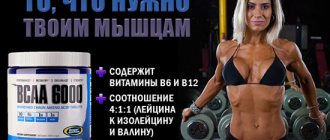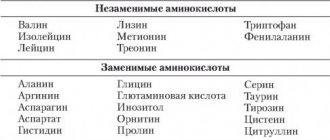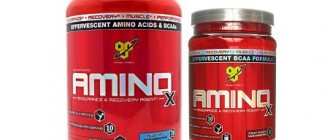When it comes to controversial types of sports nutrition such as amino acids (for example, BCAA or glutamine), doctors’ reviews about the advisability of taking them are, from our point of view, the decisive argument.
In order to understand the question “Which is better: protein or amino acids (+bcaa)?”, we asked the chief physician of one of the clinics, collected reviews from several well-known experts, and in conclusion simply used common sense. Read on and find out what is better...
Main thoughts:
The entire range of amino acids the body needs can be obtained from natural food proteins.
Feedback from the chief physician: “.. taking amino acids is not natural for a healthy body”
Feedback from the chief physician: “.. I don’t see sufficient justification for the use of individual amino acids (including bcaa) in the form of supplements”
Feedback from the chief physician: “.. it is important not just to deliver amino acids, but to obtain them correctly (break them down), during which muscle growth hormones are released”
Examine.com Physician-Researcher Review: “..BCAAs are most likely only effective for untrained (beginner) athletes during prolonged training.”
When there are too many BCAA amino acids and protein in the diet, the activity of the mTOR enzyme increases, which stimulates the growth of biological tissues, including cancerous ones. This is why scientists do not recommend taking BCAA amino acids in supplement form, nor do they recommend taking too much protein.
The daily requirement for leucine, one of the most important amino acids for muscle growth, can be satisfied by eating 300 g of beef; making it even easier with a protein shake
Amino acids are important, they are the basis of life, building blocks for the creation of muscle cells and the synthesis of hormones... and all that...
This is true.
But.
When you have a headache, what is better: take one tablet, as prescribed by the doctor, or ten, so that the pain goes away faster?
Balance is important.
In large doses, amino acids (BCAAs, glutamine, arginine, etc.) and any other most beneficial substances can turn into poison.
However, among bodybuilders (both amateur and professional) there are many who are guided by the principle of “the more the merrier” when it comes to sports nutrition, swallowing doses of amino acids in the form of supplements, sports proteins and natural products every day that exceed the recommended ones. 10-20, and sometimes 40 times!
Many reputable nutritionists, athletes and scientists today agree that “ if you are healthy, you do not need special sports supplements at all .” Everything you need can be taken from natural food.”
And this is a fact that would not hurt to frame it and hang it in prominent places in all sports nutrition stores, gyms and... somewhere in your head.
The entire range of amino acids the body needs can be obtained from natural food proteins.
In order to understand the question of which is better, protein or amino acids (including bcaa), we collected reviews from some doctors and scientists. As new facts are discovered, the information in this section will be updated. To stay informed, subscribe to our newsletters at the bottom of the page.
As an addition to the topic under consideration, be sure to read our material How to take BCAA amino acids and... is it worth it? Maybe protein is better?, where we tell how scientific research is “done” confirming the effectiveness of these amino acids, and as an illustration we give an example of the well-known resource bodibuilding.com, which stimulates sales of bcaa amino acids, relying on fictitious “scientific” data for which they paid.
Protein
Let's start our study with the characteristics of proteins. Many have heard that proteins are the same proteins, only in high concentration. They consist of hundreds of chains of amino acids connected by peptide bonds. When protein enters the human stomach, the bonds begin to break down, causing the amino acids to become independent. Due to their smaller size, they easily leak through the walls of the gastrointestinal tract into the blood, which quickly delivers them to the muscles. It turns out that proteins are sets of amino acids. Such information not only does not answer the question of which is better, protein or amino acids, but it further confuses the novice bodybuilder. Indeed, if the general functions of these two products are approximately the same, what is the difference?
Choosing the right protein
Many manufacturers use all possible tricks and tricks in order to reduce production costs. Some resort to outright falsification. Therefore, today we will approach the issue of choosing a protein mixture as scientifically as possible. What should you look for when choosing protein and how to choose an inexpensive and high-quality one?
So. For those who don’t know that choosing mixtures is not so simple, watch my previous videos in which I analyzed the composition:
https://youtu.be/G0A-6iXxcz8
If you've been on a diet and have been using nutritional supplements for several years, then you may have come across the fact that protein prices are constantly rising.
To reduce the cost of producing their product and get more net profit from sales, some companies have found a way to cheat the system, and quite legally. This is especially common in the West. Details in my previous issues, in which I talked about foreign manufacturers. Taurine, glycine. What do they do in a protein shake? You've probably seen these amino acids in the composition.
These are molecules of taurine and glycine. Red nitrogen bonds are the root cause of all problems. With prices rising, you may later notice a few new ingredients in your protein powder—primarily taurine and glycine, and possibly others.
But what's the big deal? After all, taurine is not a bad supplement and definitely not dangerous.
But if I tell you that in your 25g scoop there is actually only 20g of real protein, the remaining 5 grams are cheap non-essential amino acids with low biological value?
Taurine and glycine are always found in natural protein, but some unscrupulous manufacturers add much more of them (absolutely legally), adjusting the protein composition.
After all, your protein can will say 25g of protein. Leading products from a big company always get away with it as they have CGMP (Community Products and Competence Management Organization) certification and numerous laboratories and laboratory testing.
When you look at the product's certificate of conformity, glycine and taurine will be labeled as nitrogen, since nitrogenous bases are protein according to FDA standards.
According to the regulations, we can have 25g of protein - tested, certified and approved. Except for one thing. It is not 100% dietary protein.
On the contrary, we have a significant amount of cheap filler from cheap amino acids that fall under the vague definition of protein by the FDA, but for the body there is still a difference: 1 gram of complete protein or 1 gram of non-essential amino acid. This problem is caused not only by taurine and glycine.
Any additional "extra" amino acids like glutamine and glutamine peptides will increase the overall percentage of protein in the mixture. Also creatine, the presence of which in the composition clearly indicates fraud. I talked about amino acids and protein in more detail here.
If you are interested, check it out.
It is important to note that there is no objection to manufacturers adding excess leucine and bca, since they are essential amino acids, expensive and more effective than the cheap and replaceable glutamine, glycine and taurine. In short, manufacturers are fooling you when they add unnecessary amino acids.
Taurine and glycine are indispensable only for the manufacturer because their low price helps to increase the manufacturer's income. Taurine is several times cheaper than whey protein concentrate. Add to this flavorings, packaging, transportation and you get exactly what you are seeing now - skyrocketing protein prices over the past few years. To stay on track, manufacturers have made certain decisions, many of which are made without taking into account your fitness goals.
What about laboratory tests? Creatine testing is confusing!
Some companies are eager to take advantage of this opportunity, with varying degrees of success.
According to the results of one Western test, creatine can give results of 143% protein per 100 grams. It's funny, isn't it? And why?
And all because creatine is one of the amino acids that contains additional nitrogen. But with the 20 common amino acids that make up protein, this situation does not occur often. Therefore, laboratory testing for % protein content or otherwise for nitrogen gives strange numbers.
Avoid Creatine in Protein! We have a positive view of creatine as one of the most proven effective supplements in sports. I talked about it here.
https://youtu.be/0F1-4h6npSg
But not in protein! This is the easiest way to inflate test results in order to get more net profit. Therefore, when a protein contains creatine, it is more likely a forgery to increase numbers in laboratory testing. Creatine supplements are difficult to test and will not give reliable results.
Summarize. Companies can save a lot of money by replacing expensive protein with cheap amino acids without breaking the law. In the West, I call this amino acid spiking.
How do they do it? Is it because the FDA supports it?
According to the FDA, pure amino acids are not considered protein, but nothing is said about protein that includes additional amino acids.
- According to the FDA, pure amino acids are not considered protein, but nothing has been established regarding protein that includes additional amino acids. To see this, look up FDA Compendium Title 21, Part 101 (Product Labeling), Article 101.36 (Food and Dietary Supplement Labeling), which specifically addresses additive labeling.
Can I list the protein on the label if my product is made up of individual amino acids? - No, you cannot list a protein on your product that only contains amino acids.
Can not understand anything? No wonder.
If you look closely at the FDA's language, you will notice that it is easy to interpret. The FDA definition of nitrogen and protein is not publicly available. Since protein powders cannot consist of only amino acids, companies have interpreted that the added amino acids may be part of the whole/total protein.
This definition is erroneous (known as "denying the antecedent") and ambiguous.
- The FDA definition of protein is not made public and cannot be found online.
AOAC International (Association of Official Analytical Chemists) is the organization that asked the FDA to set standards for measuring protein.
The above provisions are confusing.
The sad truth is that the FDA cannot finalize its interpretation. They blame the AOAC, citing their 1990s manual based on analysis methods dating back to the 1800s.
According to section 101.9 (nutrition of food labeling), part (c)(7), addresses the issue of protein:
Protein content can be calculated based on the Code of Federal Regulations 6.25 requirements for dietary nitrogen as specified in the appropriate method of analysis in AOAC International (formerly the Association of Analytical Chemists) Official Methods of Analysis, 15th edition (1990), which contained in 5 USC 552(a) and 51 CFR, except for official procedures relating to certain foods that require additional conditions in accordance with the Code of Federal Regulations.
Therefore, FDA definitions of the terms “nitrogen” and “protein” are not publicly available, not just in supplements, but in food in general.
Kjeldahl method. AOAC uses the Kjeldahl method to determine protein in milk, dairy products and milk-based food additives. After all, almost all of the protein nitrogen tests in Volume I were done using the Kjeldahl method, and they still refer to it in their papers and procedures.
What is this Kjeldahl Method? This test is used to determine nitrogen in chemical elements.
In a nutshell The Kjeldahl method, which is used to determine the % protein in a mixture, is outdated.
Although this method works great for measuring nitrogen, it is outdated for measuring dietary protein because... This is a good approximation, but there is room for error since many chemical compounds contain a nitrogen bond. Anyone can add some kind of impurity to protein powder, urea, for example, and call it protein.
This approach caused a scandal in 2008 with melamine in Chinese milk powder. Melamine was added to food and animal feed to simulate high protein content - one of the most important indicators of product quality that determines its nutritional value.
The small molecule melamine contains 6 nitrogen atoms in its structure, so even a slight admixture of this chemical compound can create the illusion of high nutritional value of a product or feed.
Some Chinese food companies have added melamine to food to increase the apparent protein concentration. 54 thousand children were hospitalized due to adulteration of baby food, all for the same reasons that are relevant today for our protein problem.
A small melamine molecule (Fig. 1) contains 6 nitrogen atoms in its structure, so even a slight admixture of this chemical compound can create the illusion of high nutritional value of a product or feed. Although the scandal resulted in two death sentences, we don't think the glycine and taurine in our protein powder will cause that much fuss. But those of us who exercise seriously should be careful, as this method of measuring protein is not acceptable.
Calculating nitrogen in protein is sloppy and outdated science.
To top it all off, the AOAC and FDA have established a protein nitrogen ratio of 6.25. This means that if you take the total nitrogen content and multiply it by 6.25, you will get the amount of protein.
Where did the number 6.25 come from? 6.25 is an approximate value! The average nitrogen content in protein is 16%, which is where our 6.25 = (1/0.16 = 6.25) comes from. I already talked about this here.
Different products have different coefficients, for example eggs-6. 25, but milk, more like whey, is 6.38. This is not a big difference, but amino acids have 5.6, and this is already a huge difference.
Now you can see, when we talk about protein, we actually take values above the norm, which is quite inaccurate. This gives manufacturers another chance to game the system. You can use amino acids, but they have more nitrogen and so we end up with more protein than we should. Let's take glycine as an example.
Its formula is C2 H5 NO2 and its molecular weight is 75.0666 g/mol. Knowing the school chemistry curriculum, we present the fact that glycine consists of 18.66% nitrogen. This means that for every gram of glycine according to Kjeldahl, there is 1.19g of protein! In fairness, we want to note that taurine is “poorer”. taurine, according to Kjeldahl, is 0.714 g of protein.
What about creatine?
1 g of hydrolyzed creatine equals 1.8 g of protein. Its formula is C4H9N3O2, these three nitrogen molecules destroy Kjedahl’s theory - according to his own calculations (non-hydrolyzed creatine 2.05 g). By the way, do you remember the melamine fiasco? It contains 67% nitrogen! Are you beginning to understand why those criminals were executed in China?
Why won't they fix this?
One reason is that the entire food industry is trying to avoid changing food standards because "scientists are afraid of opening Pandora's Box." The change will take a huge amount of time and money - labeling products properly, especially where the nitrogen content is compromised.
So! How to study a label
Let's note that free amino acids (or creatine) may be added in excess to the mixture. If the protein manufacturer is “honest” in quotes, then he will indicate a complete list of amino acids on the label.
Example of an amino acid profile. Pay attention to the natural amount of glycine. However, taurine should not be found in dietary whey protein. If we look at the amine profile on the packaging of some mixtures, it is often found.
If it is in the product, it was added on purpose. Artificially. In a small amount - more or less, but exceeding even one gram is not permissible. How is this dangerous?! The real problem comes when extra amino acids are added to your protein, but they are not listed on the label. What if additional amino acids are added to a product but not listed on the label? This is a pressing issue, but unfortunately few of us will touch it. The fact is that if you purchase a protein product, test it, and publish the data, you are opening yourself up to litigation.
So the manufacturer may not know that his products are packed with extra amino acids. The fact is that if a manufacturer receives raw materials from another source (already with additives), which also had to undergo testing, then he himself will not know that his product is of poor quality. More thorough testing of raw materials by the manufacturer would reduce competitiveness in relation to those manufacturers who do not conduct tests and do not spend money and time on them.
At this point, it is almost impossible to tell how real your protein is and how many amino acids are added. How do you know if your protein is packed with amino acids? Consider two common situations:
1. Questionable amino acids - inside your “protein mixture”.
There is no real point in adding amino acids to the composition. Consequently, any addition can be regarded as a decrease in the biological value of the product and an increase in the percentage of nitrogen.
2. The questionable amino acid is listed in the composition after the food protein.
In both of these cases, it is impossible to know how much actual protein is in the product because all of these ingredients are considered “protein.” In the second example, we can be relatively sure that there is not too much L-glutamine in there since it is listed after the cocoa powder. But there is enough taurine here, and it is listed after the protein.
You can calculate approximately how much taurine a product contains by referring to the label, but this is not always reliable. The only correct solution I see is to refuse to buy proteins with additional amino acids.
- Golden Rule. First of all, never buy protein with creatine inside. 1 gram of creatine (monohydrate) is considered as 1.8 g of protein according to Kjeldahl.
- Secondly, do not buy a product that contains additional taurine, glycine, glutamine or creatine. Especially if there is no amino acid profile on the package. But, if taurine, glycine or glutamine are listed at the end of the list of ingredients, or after flavorings, and we have an additional amino acid profile where there is less than 1 gram of taurine then you can buy it, especially if it comes at a discount.
Pro tip: If you are wondering about a particular protein supplement that most foreign brands produce, and you are holding a jar without an amino acid profile, then you should find out if it is available in France and read the ingredients in French. Some European countries, such as France, require complete information on amino acid composition. Google the picture of the French label to see how bad the situation is.
If you take the side of taurine and creatine, these are harmless and safe supplements for the athlete. And creatine is like that in general. However, when you pay money for a product, you expect to receive the full complement of essential amino acids from animal protein. When amino acids are added to a product, this is no longer what you pay money for.
So! Summing up and summing up
Real problems:
- Nobody wants to be fooled.
- Good companies do not deceive their customers, even if they are not in a very advantageous position.
- Some companies add the extra (non-essential) amino acids taurine, glycine, glutamine and creatine to their protein powder. They list these amino acids as "dietary protein" on the package, when in fact it is not as healthy as a complete protein with a natural amino acid composition. This saves a lot of money.
- Due to the FDA's imprecise and ill-conceived definition of "protein", amino acid spikes are completely legal.
- Adding creatine to products is the most serious deception. Briefly about how to study labels:
- Never buy protein with creatine
- Always avoid proteins containing taurine, glycine or glutamine.
- It is likely that there are products that contain these amino acids, but they are not indicated on the packaging. And we can barely get to the bottom of it without serious and extensive testing. goals.
I would like to express my gratitude to Marina Bogdanova for her help in preparing the material.
Sources:
- Protein shortage / huge increase in price coming?; Laxter (quoting BK); Bodybuilding.com Forums; June 18, 2014
- Weekly Whey Protein Concentrate Price, University of Wisconsin Department of Agricultural and Applied Economics
- WPC and SMP Prices, CLAL
- Bulk Taurine, Alibaba.com
- Bulk Glycine, Alibaba.com
- FDA.gov, CFR – Code of Federal Regulations Title 21
- Denying the antecedent (Logical Fallacy); Wikipedia
- Code of Federal Regulations Title 21, Part 101 (Food Labeling), Section 9 (Nutrition labeling of food); FDA.gov; April 1, 2013
- The Freedom of Information Act 5 USC § 552; The United States Department of Justice; 1996
- Official Methods of Analysis of AOAC INTERNATIONAL, 19th Edition (2012); AOAC International
- AOAC: Official Methods of Analysis (Volume 1), 15th Edition, 1990; The Internet Archive
- AOAC: Official Methods of Analysis (Volume 1), 15th Edition, 1990; Public.Resource.Org
- Protein Nitrogen Content of Milk; AOAC International
- Appendix F: Guidelines for Standard Method Performance Requirements; AOAC International; 2012
- Kjeldahl Method; Wikipedia
- FDA: Melamine found in baby formula made in China; Weise, Elizabeth; USA Today; September 15, 2008
- Two executed in China over tainted milk; CNN; November 24, 2009
- Amending the Method of Calculating Protein Content in Human Food; Protein Technologies International, Inc; Dec 21, 2000
- Converting nitrogen into protein–beyond 6.25 and Jones' factors. Mariotti, F; AgroParisTech, INRA; 2008
- Methods of Food Analysis; Food and Agriculture Organization of the United Nations
- Taurine/Glycine – The Discussion Ends. WARNING! Science Content Inside.; Mentalist72; BB.com Forums
Amino acids
Let's consider the second sports nutrition product. Amino acids are organic compounds that mainly contain nitrogen, oxygen, hydrogen and carbon. In total, there are 20 known species, of which only 11 can be produced in our body, that is, they are replaceable. We can only obtain 9 amino acids from the outside (from food or dietary supplements).
Amino acids consumed in their pure form (dietary supplements) do not require time to break bonds, since they are independent from the very beginning. Once in the stomach, they unusually quickly seep into the blood and, with its current, rush to the muscles. The whole process takes them 15–20 minutes. For comparison, we note that proteins require an hour or more from the moment they are taken until they enter the muscles. It may seem that the answer to the question of which is better, protein or amino acids, suggests itself. But let's not rush. Let's look at what functions these two products perform.
What are complex amino acids?
This is just protein, compressed into tablets, caplets or packaged in capsules . The following types of protein are used for this:
- Whey hydrolyzate
- Whey concentrate
- Casein
- Egg albumin
- Soy isolate or hydrolyzate
- Blend of different types of protein
- Dried beef liver
Only those complex amino acids are worthy of your attention, the only raw material for the production of which is hydrolyzed whey protein . This is really a very good product, since the protein in it is already partially digested (that is, broken down into peptides), thanks to which it is very quickly absorbed and fills the bloodstream with amino acids.
If complex amino acids contain other types of protein, there is no point in purchasing them. Why would you buy the same whey protein compressed into tablets at exorbitant prices when it is much cheaper to buy it in powder?
Of course, you may object: why buy compressed whey protein hydrolyzate, if it can also be purchased in powder form? Well, it's a reasonable question. In addition, powdered whey hydrolyzate will cost you slightly less than a can of complex amino acids that is similar in weight and protein content. However, tablets and capsules have their own advantages.
The benefits of proteins
These substances contain not only amino acids, but also other useful components. The role of proteins in the body is difficult to overestimate. They perform the following functions:
- Reproductive.
- Hormonal.
- Transport.
- Signal (transmit signals between cells).
- Reserve.
- Catalytic (provide chemical reactions).
- Protective (increase and strengthen immunity).
- Receptor.
- Motor (for example, they provide muscle contraction).
The most important function of proteins for bodybuilders is that they increase muscle mass, relieve muscle pain, and restore strength.
If you pay attention to such an impressive list of advantages, the answer to the question of which is better, protein or amino acids, again becomes unambiguous. By consuming proteins that contain at least 70% protein, a person gets the opportunity to keep his body in excellent shape. Slow absorption into the blood is their only drawback, but in some cases it also becomes an advantage.
Egg protein
In my opinion, this is the most “unsuccessful” protein. Let everyone say that it is best absorbed, but egg white lacks 3 amino acids (2 of which are essential): serine, lysine and valine. Of which, the latter is very important and is part of the BCAAs. Thus, of the BCAAs, egg white contains only isoleucine and leucine. And this is a rather low figure for BCAAs (about 15%). Egg whites also contain the least glutamine, but the most alanine.
In total, there are the least essential amino acids – 43%. In addition, egg protein is more expensive than whey protein. As a result, 5 last places and 5 first.
Benefits of amino acids
This product has practically no additional impurities and additives, so it has fewer functions. However, amino acids provide many benefits in bodybuilding:
- Reduces appetite (an excellent property for those who need to lose weight and those who are engaged in “cutting”).
- Relieves muscle pain after heavy physical activity.
- Quickly restore strength.
- Prevents catabolic processes in muscles.
In addition, these chemical compounds have the same beneficial properties for the body as proteins, just not all at once. Each amino acid, let’s say, is responsible for its own area of work.
It turns out that the properties of the two dietary supplements under consideration are approximately the same. Now let's try to answer the question of what is better to take, protein or amino acids. If a person only cares about the appearance of his body, and wants to get results quickly, then he should opt for amino acids.
Anyone who wants to increase their muscles and improve their health, but it doesn’t matter to them whether the product starts working in an hour or in 10 minutes, can stick to proteins.
However, not all so simple. The fact is that proteins are also different.
Squirrels are fast
There are some on sale too. These include whey protein, which is considered one of the healthiest foods produced by man. More precisely, nature produces it, and people only isolate it from various plant and animal components. This protein in the stomach quickly breaks down into amino acids and penetrates into the blood.
Whey protein is commercially available in the form of concentrate, isolate and hydrolysate. Don't think that concentrate is the most concentrated protein. On the contrary, this product contains the least amount of the treasured “building blocks” for muscles (about 70% of the total composition), which is why it costs less than other supplements. Maximum amount of protein in isolate (up to 97%).
Hydrodisates are protein partially broken down into amino acids, which ensures the speed of its absorption into the blood. However, this does not affect the final result.
Fast proteins can reach the muscles within 40 minutes after the athlete takes the product.
Protein absorption rate?
A favorite marketing ploy is fast- and slow-digesting protein , and people tend to immediately associate whey as a “fast” protein and casein as a “slow” protein.
Technically, there are differences in the degree of absorption, and the main ones are distributed - from fastest to slowest - as follows:
Hydrolyzed casein ≥ hydrolyzed whey > whey isolate ≥ whey concentrate > other protein sources > casein
Basically, these two hydrolysates are the fastest, followed by whey options, other protein sources, and finally casein protein.
But does it matter?
Hardly.
This is a confusion in research, and here are the main reasons:
- The rate of muscle protein synthesis seemed to be determined by how quickly the protein entered your bloodstream;
- However, these are short-term studies. If we just look at muscle mass (the thing we're really concerned about) - there is some evidence that slower proteins build more muscle in the long term;
- Thus, "slow" proteins may be better because they are absorbed more efficiently .
And although the rate of muscle protein synthesis of "faster" proteins is better than that of "slower" proteins, slow-digesting proteins actually produce more muscle mass . Therefore, concern about the rate of protein absorption is not justified for the average person.
Proteins are slow
These are soy protein and casein. In addition, this group includes all proteins enclosed in a special matrix that prevents their rapid digestion. Slow proteins take a very long time to break down into amino acids, and the process of feeding muscles can take 6-8 hours. Their other disadvantages are that they do not have high biological value, have a weak anabolic effect when gaining muscles, and have few amino acids in their composition.
But don’t rush to add them to your list of unnecessary products. All proteins and amino acids in sports nutrition have their own value. The main thing is to take them correctly. Don't think that you only need to consume amino acids to get a great body. Proteins, even slow ones, will also be useful to you.
AMINO ACIDS: BRIEF DOSSIER
| Form | Functions | pros | Minuses |
| "Free" amino acids | Does not require digestion; fast absorption | You can take certain types of amino acids in large doses (for example, those that reduce muscle catabolism) | Relatively high price |
| Hydrolyzed protein | Accelerates absorption | Preliminary processing | Contains short chain peptides that increase hormone levels (IGF-1) |
| Branched chain amino acids | Increases ammonia production during exercise by promoting the formation of alanine from glucose | Can be converted into energy, preventing muscle catabolism | A relatively expensive method of energy “feeding” muscles |
| Di-/Tripeptides | 2-molecule and 3-molecule protein chains, better absorbed by the body | Increases the level of the anabolic hormone IGF-1 (increases the efficiency of protein use by the body) | High price |
| Plant proteins | Proteins intended for vegetarians and lovers of plant foods (beans, nuts) | Low price, low fat, rich in antioxidants, fiber | Incomplete amino acids (except soy) must be combined with missing amino acids |
| Animal proteins | Dairy products, poultry, eggs, meat (beef), rich in essential amino acids | Typically contain all essential amino acids (except gelatin) | Rich in saturated fat |
When and why to take amino acids
Above we found out how amino acids differ from protein. These differences are not disadvantages, but determine the advisability of taking each product.
Since amino acids begin working in the muscles very quickly, they should be taken immediately after the end of the workout. They will quickly restore strength and relieve tension in muscle tissue. You can also drink them twice a day - before and after training. In this case, they will actively help gain muscle mass.
If you decide to lose weight with the help of amino acids, you need to use them 4-5 times a day, replacing them with any meal. Remember, since these substances quickly begin their work, they finish it quickly. That is, the body will not have enough of them for a long time.
How to take amino acids
Amino acids and proteins for sports nutrition come in different forms. So, the former can be purchased in powder, tablets, capsules and ready-made solutions. All release forms are good and work the same. Therefore, you can choose the one you like best. There is no consensus on the dosage. Some believe that it should be 2 grams per 1 kilogram of a person’s weight, but not more than 20 grams at a time. Others raise the bar to 30 grams at a time. The only consensus reached was that a single dose should not be less than 5 grams. You can drink the drug or dilute the powder in water, juice or milk. If you are not allergic to lactose, then it is preferable to choose milk. This way the body receives additional vitamins.
Complete amino acid profile
Having consumed a protein shake, we will not have that amino acid profile; we will still need to work and break down the protein.
The absorption of amino acids from protein will occur gradually as the elements are broken down. And even if we break down the entire portion of protein, we will not be able to achieve the same amount of amino acids that are in BCAA.
The transport capacity of the intestine is limited, and a large number of amino acids are simply not absorbed.
Everyone recommends consuming about 10 grams of glutamine and 15 grams of amino acids. This amount will be contained in two servings of protein, which will be absorbed in at least half an hour. And here we use everything at once. The body is guaranteed not to absorb all the amino acids that we consumed.
Instead of help, the body receives nothing. Scientists do not have an exact idea of how much amino acids need to be consumed in order for competition for transport channels to decrease. If you are impatient and vomit in one place, it is better to eat 5 grams of each amino acid after training. This is the amount that will be obtained from one serving of protein - 5 grams per amino acid.
Read your amino acid jar and calculate to consume no more than 5 grams of amino acid.
This way, the channels will not become clogged, and you will increase the absorption of substances. A little more about the struggle for channels. If you eat a lot of BCAAs, this prevents tryptophan from entering the brain, which is very important. People with migraines or insomnia should have their own calculations and precautions in this regard.
Scientific fact.
Amino acids are absorbed into the body in 15 minutes, and whey protein will give the maximum concentration of nutrients after one hour and support will last for two hours. If you are concerned about catabolism during training, then the best way is to consume whey protein an hour before training. During training, the level of amino acids in the blood will reach a maximum.
How to take fast proteins
They are produced mainly in powder for making cocktails. The rules for using these drugs depend not only on whether you take fast or slow proteins. What you decide to use them for is also important. So, if you need to lose weight or do “cutting”, you will need fast proteins. The ideal option is whey protein in isolate form. It should be consumed in the morning and before training. The dosage is ½ of the usual rate, that is, 10-15 grams at a time. It is advisable to prepare such cocktails using water. In addition, it is useful to take them throughout the day, replacing 1-2 meals with them. Proteins are especially useful for people on diets, as they supply the body with substances necessary for its functioning, which are usually not enough in the diet menu.
To gain muscle mass, you need to take protein, like amino acids, before and after sports activities. The only difference is the time before training. So, amino acids are taken 30 minutes before the start, and proteins - 60 minutes so that they have enough time to reach the muscles and start working. In this case, you need to take a standard dose of 20 grams.
Pros of amino acids
1. Amino acids do not need to be digested
This means that amino acid complexes are absorbed much faster than protein. Since protein must first be broken down into amino acids. The time difference is not very significant. Approximately 1 hour (highly depends on the type of protein). For the body and for progress, this difference is not critical. Therefore, although this is a plus of amino acids, it is not significant.
2. Amino acids contain less fat and carbohydrates
Most amino acids are pure amino acids without impurities of fat and carbohydrates. On average, proteins contain 5% fat and 10% - 15% carbohydrates. Thus, amino acids are more suitable for weight loss. However, there are also proteins with a minimal content of carbohydrates and fat, which in this regard are not inferior to “amines”.
3. Amino acids are more convenient to take
To take them, you don’t need to have a shaker, constantly stir cocktails and then wash it all. There is no need to constantly buy milk, which constantly turns sour in the heat, etc. You just need to throw a handful of tablets into your mouth and wash it all down with water.
Is it possible to eat amino acids and protein together?
This is an ideal solution for both weight loss and giving the desired body shape. It is not only possible, but also necessary to combine these two products. Protein is great to take in the evening and during the day. You need amino acids after waking up, before and after sports activities. If you do not have a visit to the gym or stadium planned, you do not need to take amino acids that day.
The only obstacle to such a wonderful schedule can be your financial capabilities. The fact is that amino acids are quite expensive - from 969 rubles for a package containing 20 doses. The price of a jar depends on the set of amino acids and the number of doses. Protein can be bought a little cheaper - from 750 rubles for 60 doses, but the price of this product depends on what kind of proteins are in the composition. Thus, some isolates cost over 3,500 rubles for 60 doses. Therefore, the financial side of the purchase depends entirely on your preferences and capabilities.
Consumer reviews and doctors' opinions
Doctors constantly repeat the truism that the body needs amino acids, proteins, and vitamins for normal functioning. Many dietary supplements include not only a heavy dose of proteins, but also vitamins, which increases their usefulness. In reviews, professional athletes and amateurs who want to impress everyone with their muscles speak only positively about protein dietary supplements. Consumers like the taste of the supplements, the pleasant sensations they feel when taking them, and the excellent results. Thus, many write that with the help of dietary supplements (both proteins and amino acids) it is possible to increase muscle growth faster and to recover more easily after training. The only complaints are about the price, which many consider unreasonably high.
The opinions of doctors are not so unanimous. There are experts who share the athletes’ point of view. However, many foreign and domestic doctors believe that drinking protein and amino acids is harmful. It is much better to consume natural products that contain a full range of substances necessary for humans. The most protein is found in beef and eggs. If these products are eaten in the right quantities, they will have the same effect as dietary supplements, but without the destructive consequences for the body.
Doctors warn that amino acids are the most dangerous to health, since they enter the blood without activating the process of protein breakdown in the stomach, which triggers many pathological processes. It turns out that their main advantage and advantage turns out to be a big disadvantage.
The amino acid lysine is especially dangerous. Dietary supplements containing it are more expensive than others, since this substance is advertised as the most effective. However, when it enters the body in large quantities, it activates the mTOR enzyme, which affects growth hormone. Doctors have established a direct relationship between an increase in the amount of this enzyme and the development of cancerous tumors. That is, lysine promotes the growth of not only muscles, but also malignant tumors.
There are negative effects on health of other amino acids entering the body in large quantities. Doctors believe that proteins are somewhat safer, since when they are consumed, the digestion process in the stomach and intestines is preserved, so all the necessary hormones are released as they are inherent in us by nature.
Which is better BCAA or natural food protein? Testimonial from Dr. Mercola
Below we present an opinion on the benefits of protein from natural products compared to BCAA amino acids: a review by a doctor, a famous foreign expert in nutrition, Dr. Mercola 2.
According to him, one of the main problems associated with the use of BCAA supplements is that “excessive intake of amino acids stimulates the release of a certain substance in the body - the mTOR enzyme.”
This enzyme determines sensitivity to nutrients and, accordingly, the release of certain hormones that regulate metabolism, growth, cell division and survival. In other words, it controls the processes of cellular growth and repair.
What does it mean?
“Depending on whether its activity increases or decreases, the growth of biological tissue or the preservation and restoration of cells is ensured: if the activity of mTOR is low, then the process of preservation and restoration occurs, which leads to an increase in the lifespan of the cell - this is the ideal and desired state .”
Important: However, an excessive amount of amino acids stimulates the activity of mTOR, which triggers the growth mechanism of biological tissues. This is justified when it is necessary to ensure muscle growth, renewal and restoration of other tissues in athletes who have developed a need for physical activity. However, doctors say that “ the growth of all cancers is associated with high activity of the mTOR enzyme (i.e., the concentration of amino acids in the blood).”
For this reason, scientists categorically do not recommend taking additional BCAA amino acids in the form of supplements, as well as consuming large amounts of protein . Amino acids are the most powerful stimulator of mTOR enzyme activity.
According to Dr. Mercola, "it is best to limit your intake of not only BCAA supplements, but also protein intake to 40-70 grams/day, depending on muscle mass."
The generally accepted recommendation is ~1 g per kilogram of body weight for ordinary people and 1.4 - 2.0 g/kg for athletes. Some bodybuilders consume up to 3 g/kg, along with various amino acids...
“It is also important to avoid consuming leucine as a free form amino acid supplement. When administered intravenously, free leucine has been found to induce a potent hyperglycemic response and insulin resistance."
Important: When eating natural foods rich in protein, the risk of “overdosing” on amino acids is minimized . If you, like most athletes, are loaded with a full load of ammunition, including huge portions of natural protein products, sports proteins, gainers, and also bcaa amino acids, glutamine, taurine, HMB and so on, then, without a doubt, you are at serious risk harm from consuming too much protein, the molecular mechanism of which may already be launched.
Read us on the networks
Review from doctor Dr. Mercola: “.. When there are too many BCAA amino acids and protein in the diet, the activity of the mTOR enzyme increases, which stimulates the growth of biological tissues, including cancerous ones. This is why scientists do not recommend consuming BCAA amino acids in the form of supplements, as well as too much protein."
We recommend : BCAA amino acids: harm and side effects











